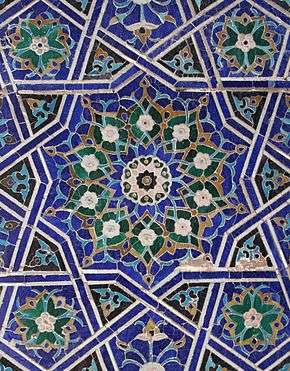Raqqa ware

Raqqa or Rakka ware is a style of ceramic pottery that was a mainstay of the economy of ar-Raqqah in northeastern Syria during the Ayyubid dynasty. The city experienced a resurgence during the late twelfth and early thirteenth centuries, but when it was sacked by the Mongols in 1259 and destroyed in 1265, manufacture of its ceramics virtually ceased.[1]
Ceramics
Ar-Raqqah's ceramics were varied in character, but have been identified during the 20th century by on-site excavations that securely linked the highly sought-after surviving pieces to ar-Raqqah.[2] Over a heavily potted body of coarse stone-paste often covered with a white slip, monochrome and polychrome underglaze stains of copper (turquoise), cobalt (blue) or manganese (purplish-brown) were covered with a greenish clear glaze and fired. Lustreware was also developed at Raqqa, after the Fatimid collapse in Egypt (1171), which until then had been the only center of lustreware production.[3]
Collections
Major collections are at the Metropolitan Museum of Art and the Ashmolean Museum.
References
- ↑ Jenkins-Madina, Marilyn (2006) Raqqa Revisited: Ceramics of Ayyubid Syria (Metropolitan Museum of Art, New York).
- ↑ Ashmolean Museum: Characteristics of Raqqa lustre.
- ↑ Ashmolean Museum: the history of lustreware in Syria.
| ||||||||||||||||||||||||||||||||||||||||||||||||||||||||||||||||||
